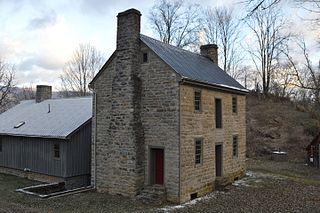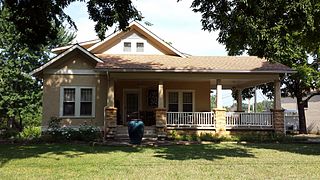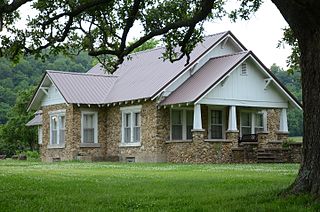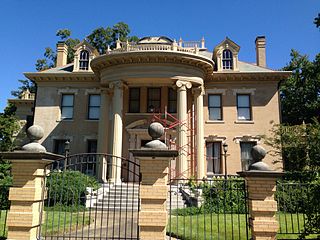
The Dunlap House is a historic house at 101 Grandview Avenue in Clarksville, Arkansas. It is a two-story wood frame American Foursquare structure, set on a tall stone foundation on a highly visible lot near the city center. Its porch, uncharacteristic for the Foursquare style, extends only across half the front, and curves around to the left side; it is supported by Tuscan columns. The house was built about 1910 to a design by noted Arkansas architect Charles L. Thompson.

The War Eagle Bridge is a historic bridge in War Eagle, Arkansas, United States, that is listed on the National Register of Historic Places.

The Scott–Walker House is a historic home located near Saltville, Smyth County, Virginia. It was built about 1800, and is a two-story, three bay, limestone dwelling with a hall-parlor-plan on each floor. It has a side gable roof and exterior end chimneys. A one-story, three room wing was added in 1992 and garage in 1993. It is the oldest known stone farmhouse in Smyth County.

The Sherman Bates House is a historic house at the northeast corner of Echo Lane and United States Route 63 in Hardy, Arkansas. It is a 1-1/2 story fieldstone structure with vernacular Tudor Revival styling. Its prominent features include a fieldstone chimney on the right side of the main facade, and a projecting stone porch on the left. The corners of the chimney and porch are fitted with carefully cut stones. The house was built in 1940 by Sherman Bates, owner of a local bulk fuel oil business. Bates owned the house until he enlisted in World War II; the house's subsequent owners were also prominent local businessmen.

The Ernest Daugherty House is a historic house on Third Street west of Kelly in Hardy, Arkansas. It is a stone structure, set into a hillside on the north side of Third Street, presenting 2-1/2 stories in the front and 1-1/2 in the rear. Rectangular in shape, it has a roof with clipped gables, and clipped-gable dormers on the sides, and exposed rafter tails. Built in 1932, it is an excellent local example of a stone house with Craftsman styling.

The William Shaver House is a historic house on the east side of School Street, north of 4th Street, in Hardy, Arkansas. It is a single story fieldstone structure, with a side gable roof and a projecting gable-roofed porch. The porch is supported by stone columns with an elliptical arch, and a concrete base supporting a low stone wall. The main facade is three bays wide, with the porch and entrance at the center, and flanking sash windows. The house is a fine local example of a vernacular stone house, built c. 1947 for a working-class family.

The Elliott and Anna Barham House is a historic residence in Zinc, Arkansas. It is listed on the National Register of Historic Places. It was the home of Elliott Barham, son of the founder of Zinc, Arkansas, and his wife, Anna Barham.

The Stone House, also known as the Walker-Stone House, is a historic house at 207 Center Street in Fayetteville, Arkansas. It is a two-story brick building, with a side-gable roof, a two-story porch extending across the front, and an ell attached to the left. The porch has particularly elaborate Victorian styling, with bracketed posts and a jigsawn balustrade on the second level. The house was built in 1845, by Judge David Walker, and is one of a small number of Fayetteville properties to survive the American Civil War. It was owned for many years by the Stone family, and reacquired by a Stone descendant in the late 1960s with an eye toward its restoration.

The C.E. Foster House is a historic house on Skyline Drive in Queen Wilhelmina State Park, located in central western Arkansas. It is a rustic stone structure, with two parts connected by a breezeway, located just outside the park entrance on the north side of the highway. It was built in 1931 by Carlos Hill and Phil Lance, and sold soon afterward to C. E. Foster, an Oklahoma oil businessman, who bought it for use as a summer house. It is one of four houses built by Hill on Rich Mountain, and is the best-preserved of the two that survive. In the 1960s the house was operated as a tourist attraction known as the "Wonder House"; it was taken over by the state in 1971.

The Bateman-Griffith House is a historic house at 316 Jefferson Street in Clarendon, Arkansas, United States. It is a brick and stone two-story structure, with a steeply pitched gable roof, with a long single-story section projecting to one side, and a stone-arch porte cochere on the other. Built in 1930, it is a locally distinctive example of Tudor Revival architecture, designed by Memphis, Tennessee architect Estes Mann of the firm Mann & Gatling.

The Jeffries House is a historic house at 415 Skyline Drive in North Little Rock, Arkansas. It is a 2 1⁄2-story wood-frame structure, finished in a fieldstone veneer, and is three bays wide, with a side-gable roof, end chimneys, and symmetrical single-story wings at the sides. The house is distinctive as a fine example of Colonial Revival architecture, rendered in the unusual veneered stone finish. Built in 1931 by the Justin Matthews Company, it was the last house Matthews built in the Edgemont subdivision before the Great Depression brought the development to an end.

The John F. Brewer House is a historic house on Arkansas Highway 9 in Mountain View, Arkansas, one block south of the Stone County Courthouse. It is a roughly rectangular single-story wood frame structure, with a gable roof and stuccoed exterior. Shed-roof dormers project from the sides of the roof, and a small gabled section projects forward on the left front facade, with a deep porch wrapping around to the right. There are exposed rafter ends at the eaves in the Craftsman style. This house, built in the 1920s, is believed to be the first Craftsman/Bungalow-style house built in Stone County.

The Wesley Copeland House is a historic house in rural western Stone County, Arkansas. Located on the north side of a rural road south of Timbo, it is single-story dogtrot log house, finished in weatherboard and topped by a gable roof that overhangs the front porch. The porch is supported by chamfered square posts, and there is a decorative sawtooth element at its cornice. There are two chimneys, one a hewn stone structure at the western end, and a cut stone structure at the eastern end. Built c. 1858, it is a rare antebellum house in the county, and a well-preserved example of traditional architecture.

The Joe Guffey House is a historic house on the north side of Arkansas Highway 110 in rural southwestern Stone County, Arkansas. Located south of Arlberg in an area known as Old Lexington, it is a T-shaped single-story wood frame structure, with a gable roof and foundation of stone piers. A tall gabled projection covers a porch supported by four square posts, with a pedimented gable end that has wide boards with a diamond pattern in the center, and applied bargeboard trim near the peak. The building corners are pilastered, and an ell extends to its rear. The house was built about 1900, and was listed on the National Register of Historic Places in 1985 for its architectural significance.

The Binks Hess House and Barn are a historic farm property in Marcella, Arkansas. Located just east of Arkansas Highway 14 on Partee Drive, it is a 1-1/2 story dogtrot house, with a side gable roof, weatherboard siding, and a stone pier foundation. A single-story porch, supported by square posts, stands in front of the open breezeway section, which is finished in flushboarding, at the center of the east-facing main facade. An ell extends to the rear. Behind the house stands the barn, built on a transverse crib plan with side shed-roof additions. Both house and barn were built about 1871 for Binks Hess, brother of Marcella's founder Thomas. The barn is believed to be the oldest in Stone County, and the first to use sawn lumber in its construction.

The Thomas E. Hess House is a historic house on Arkansas Highway 14 in Marcella, Arkansas. It is a two-story I-house, five bays wide, with a side gable roof, weatherboard siding, and stone foundation. A two-story porch extends across the middle three bays of the north-facing front facade, with some jigsaw decorative work and turned balusters. An ell extends to the rear, and the rear porch has been enclosed. The house was built in 1900 by Thomas E. Hess, grandson of William Hess, the area's first white settler. Other buildings on the property include a barn, stone cellar, and a log corn crib that was originally built as a schoolhouse.

The Darden-Gifford House is a historic house in rural White County, Arkansas, north of Arkansas Highway 5 near the community of Rose Bud. It is a two-story wood frame structure, with a side gable roof, weatherboard siding, and a two-story porch sheltered by a projecting gable-roofed section. It was built in 1887 by J. S. Darden, a local sawmill owner, and was built using the choicest cuts from his mill, resulting in extremely fine quality woodwork. The house and 160 acres (65 ha) were sold by Darden in 1908 to J. S. Gifford, and was sold to a Priscilla Stone.

The Greene Thomas House is a historic house in rural Searcy County, Arkansas. It is located north of Leslie, on the west side of County Road 74 south of its junction with County Road 55. It is a single-story stone structure, fashioned out of smooth rounded creek stones. It has a front-facing gable roof with an extended gable supported by large brackets, and a porch with a similar gable, supported by sloping square wooden columns. Built in 1930, it is a fine regional example of Craftsman style architecture in a rural context.

The Taylor-Stokes House is a historic log house in rural southeastern Stone County, Arkansas. It is located off County Road 37, about 0.5 miles (0.80 km) west of Arkansas Highway 14, south of Marcella. It is a saddle-bag log structure, with two log pens on either side of a central chimney. A gable roof covers the pens and extends over porches on either side of the pens. The log structure is sheathed in weatherboard. Built in 1876, it is one of the oldest known log structures in Stone County, and the only one that is a saddle-bag variety.

The Hotze House is a historic house at 1619 Louisiana Street in Little Rock, Arkansas. It is a 2-1/2 story brick structure, with a combination of Georgian Revival and Beaux Arts styling. Its main facade has an ornate half-round two-story portico sheltering the main entrance, with fluted Ionic columns and a modillioned cornice topped by a balustrade. Windows are topped by cut stone lintels. The hip roof is topped by a balustrade. Built in 1900 to a design by Charles L. Thompson, its interior is claimed to have been designed by Louis Comfort Tiffany. Peter Hotze, for whom it was built, was a major cotton dealer.



















